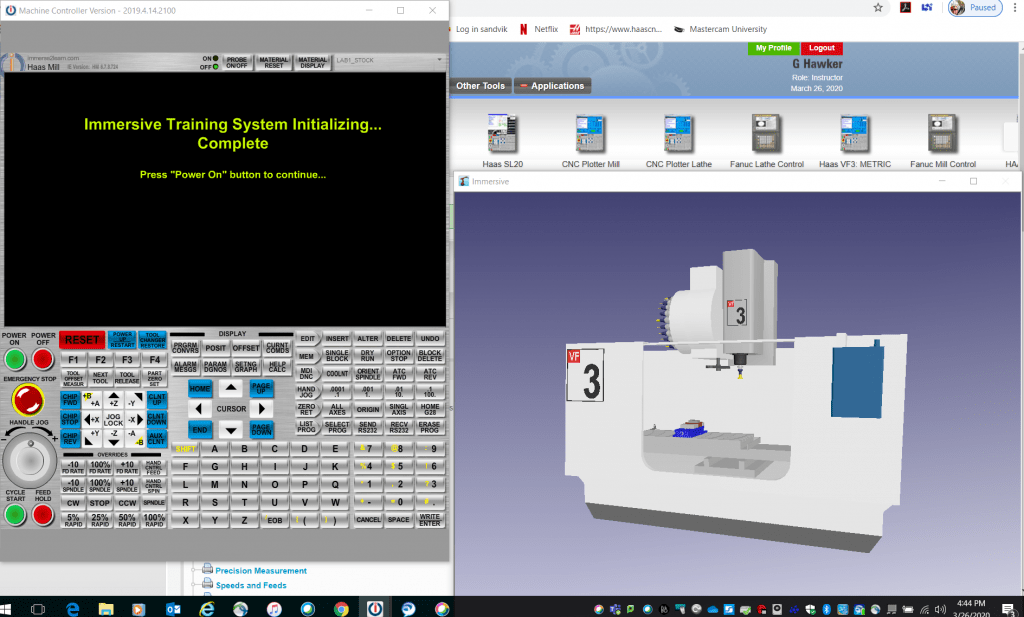Trades and Technologies programs shift to online delivery
Since the onset of the COVID-19 pandemic, Red River College’s trades and technologies programs have had to come up with new strategies for helping their students achieve learning objectives.
On March 13, the College made the decision to close its campuses and transition all courses online, in an effort to reduce the spread of the virus in Manitoba. For programs that relied heavily on hands-on, applied learning, that meant being resourceful and finding creative ways of teaching remotely.
“The students in these programs tend to come to the College because they are looking for hands-on experience,” says Evan Himelstein, program coordinator for Mechanical Engineering Technology. “What we’re trying to do is find ways to incorporate different technologies, so the students are still getting as close to the same experience we would normally provide.”
Simulated CNC milling
Glen Hawker, an instructor of Manufacturing Technician and Precision Metal Machining programs, has been able to deliver a near-identical machine learning experience to his students through simulation software licenses provided by Haas Automation.
The software carries all of the College’s lathe and milling machines, and allows students to explore the corresponding control panels from their homes. They can still complete assignments and create programs to run virtually — the only difference is they’re not creating a physical piece, or handling the machine’s tools.
“They have to follow all the steps: turning the power on, allowing it to power up, resetting and loading the program. And they have to do it safely,” says Hawker. “If they don’t follow the safety protocols, the simulation jams the same way the machine would.”
Hawker sees the technology as a definite advantage, noting his students now have more one-on-one time with the control panels while learning. In a lab setting, they’re typically split into groups to share a machine.
“This is something we could continue in the future to make our students better,” he says.
Customized on-camera training
Automotive Technician instructor Rahim Hosein was well prepared for the shift, having spent the last five years moving his course material — including all PowerPoints, quizzes, assignments and final exams — to LEARN. In recent weeks, he’s been using WebEx to communicate with his students in an online classroom setting.
“The theory portion of the course was a simple flick of a switch or click of a mouse to move to online class, and I found that being on camera in front of my students was about the same as standing in front of the classroom,” he says.
The practical portion proved more challenging. Hosein checked YouTube for clips related to what he was teaching, but finding them lacking, opted instead to create his own interactive videos using a Lumens Ladibug document camera.
With the Ladibug, Rahim can demonstrate the tools required for a specific task, how to use each tool and how to complete a repair — all while his students observe and ask questions. He says they’re as interactive as they would be in a regular class, and by the end feel confident in their ability to perform tasks — for example, replacing the brakes on a vehicle.
“I know nothing can replace the actual hands-on learning,” he says. “I debated making videos of myself ahead of time and sharing with the students, but I realized that the slowed-down method, and the ability to stop to ask a question and get immediate feedback, was crucial.”
Flexibility in programming
Whether moved there over a few years, or a few weeks, all of RRC’s trades and technologies courses and programs are now being delivered online. Electrical instructor Ryan Peters is one of the people who helped colleagues install and familiarize themselves with the online platforms currently in use.
“We set up a few impromptu training sessions during Study Week to make sure everybody would be ready for the next week,” says Peters. “And now that we’re in it, we’ve had to change and adapt on the fly. It’s really opening up everyone’s eyes to how flexible we can be with delivery and instruction.”
Many instructors use Webex as their teaching platform and Microsoft Teams as their main communications platform. Materials are being uploaded into LEARN every day so students are provided with information, resources and videos that enable them to succeed in their courses.
“We’re still able to offer training through a global pandemic,” he says, “and offering a high level of education, where in other provinces that may not be the case.”

